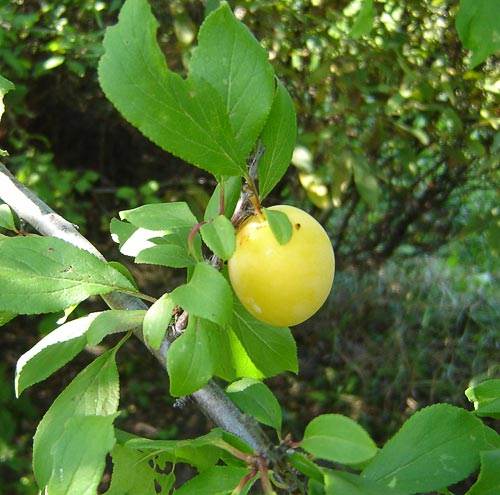Crops
Prunus cerasifera Ehrh. - Cherry-plum.
Taxonomic position.
Family Rosaceae Juss., genus Prunus L.Synonyms.
Prunus divaricata Ledeb.Biology and morphology.
2n=16Tree or multi-barrelled bush from 1,5 to 15 m tall and to 50 cm diameter of the stem. Cortex of the old branches is dark-grey, smooth or peeling. Cortex of the young shoots is from green to red-brown, smooth. Leaves oval, ovoid or oblong, from light green to dark-green (on average 20-40 mm length, 10-30 mm width). Apex is sharped or stretched. Edge of the blade is serrate or serrate-crenate notched. Petiole (5-30 mm) is green, red-brown and even violet. Petiole and lower leaf surface puberulent by rare or thick hairs, but meets and glabrate forms. Flower diameter 18-25 mm (to 40-45 mm). Calyx is green or pinkish-red, 8-15 mm in diameter. Petals (5, at hybrid sorts theirs more), white, with pinkish thin border in the middle, 5-15 mm length, 3-10 mm width, oval, ovoid or obovate. Stamen 20-30 (sometimes from 15 to 40). Fruit is juicy drupe 10-50 mm length, from rounded to dropformed and oblong, naked, from pale-yellow to almost black. Waxen deposit is from weak to thick. Pulp is mainly delicate, watery or farinaceous, yellow, red or pinkish. Stone is from shorten, almost round to sabreform or oblong (5-25 mm length, 8-18 mm width). Surface of the stone is smooth, rugged or pited. Average mass of the fruit is 17 g.
Distribution.
The most ancient center of culture of a cherry plum in territory of the former USSR is Armenia. Industry cultivation of Cherry-plum in USSR started in 40-50-th years of 20 century. Modern distribution within the limits of the former USSR - southern areas of Ukraine and Russia, Moldova, Caucasus, Central Asia, where plantation occupy more than 10 thousand hectares. It meets as in Leningrad region.Ecology.
Successfully grows on the most various sites on a relief and soil. One in the most salt-stable fruit breeds. Grows in the conditions of the irrigation on the all places and soils useful under gardens. Cherry-plum have a short period of the deep rest. A winter-hardy species. The early flowering sorts for appearance petals needs sum of the active (above 0°C) temperatures since 1 January 279°, for the beginning of the flowering - 320°C, late flowering sorts 337° and 425° accordingly. Flowering earlier of the expansion foliage or simultaneously with it. Some sorts (Pionerka, Ljusha Vishnevaja Rannaja, Otlichniza, Kiziltashskaja) - after expansion foliage. Intensive growth of the shoots starting after flowering with coming the stable warm weather. The top yield is reached in the age 8-10 years. It's live 50-60 years in conditions of culture (productive period is 35-45 years). Long period of ripening: from 20 June till 20 October.Economic value.
One of the most early maturity fruit species. Average annual harvest from one tree 25-97 kg, maximal - 347 kg (sort Krasavitsa). Averige yield about 12-13 tonn per hectare. The productive period of 35-45 years. The most popular sorts: Urozainaja, Ljusha Vishnevaja Rannaja, Krimskaja Pozdnaja, Purpurovaja, Vasil'evskaja, Obil'naja. Fruits contain 10-12 % of sugars, 4-5 % of citric and apple acids, up to 0,12 % of pectinaceous substances, vitamins A and C. Fruits are used for preparation of jams, jelly, juices, dried pastilles. A cherry plum is the major stock for plums and one of the widespread stocks for a peach and an apricot. Used in the decorative gardening.Literature.
Bahteev F.H. The major fruit plants. I., "Prosvezhenie", 1970, 351 p.Eremin G. V. Cherry-plum. M.: Kolos, 1969. 168 p.
Intensive gardens of cherry-plum / Ed.by I.I. Prokhorov. Moscow. "Agropromizdat", 1989, 20 p.
Kovalev N. V. Ecological differentiation of the cherry-plum - Prunus cerasifera Ehrh. (s. l. Kov.) // Reports of the Academy sciences USSR. Vol. 23. 1939. P. 285-288.
Kovalev N.V. Cherry-plum in nature, culture, and selection. Tashkent, 1955, 212 p.
Luneva N.N. Species of Cherry-plum of USSR Flora, their taxonomy and geography. Leningrad, 1985, 17 p.
Trees and shrubs of USSR / ed. S. J. Sokolov. Vol. 3. М.,; L.: Nauka, 1954. 871 p.
Vitkovskij V.L. Fruit plants of the world. St.-Petersburg-Moscow-Krasnodar. Lan'. 2003. 592 p.


